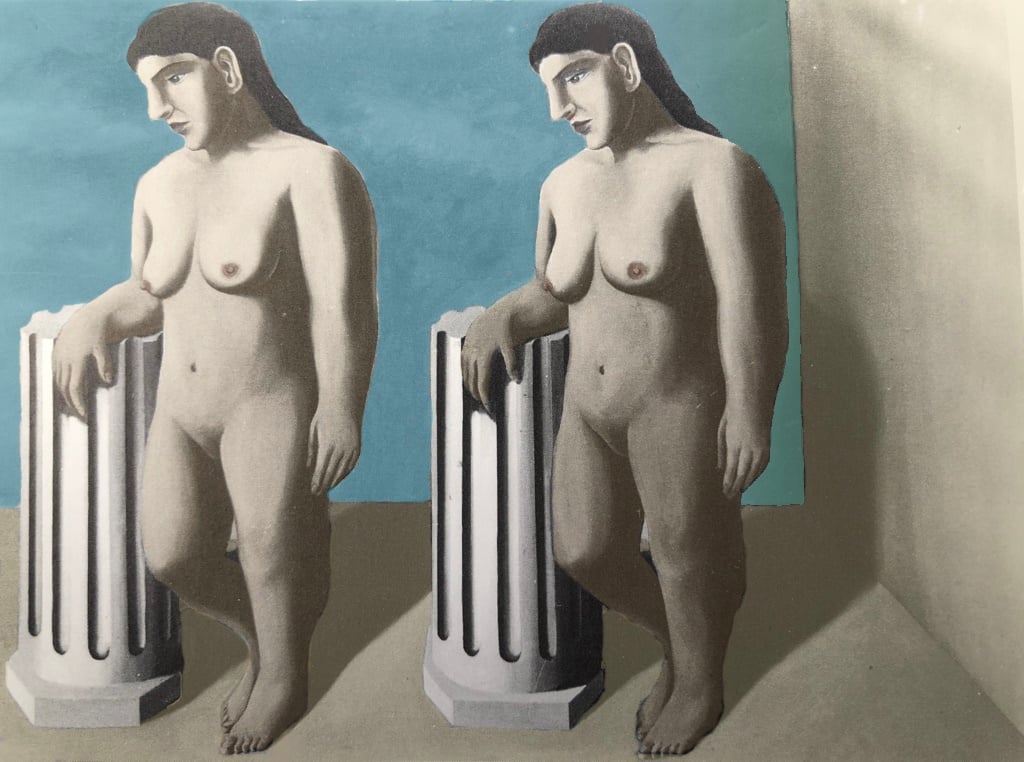
Researchers in Belgium have come upon a René Magritte painting that harbors a long-sought secret.
In the early 1930s, the Belgian artist was poor enough that he reused canvases, painting over one work with another. In one case, he cut one of his paintings—The Enchanted Pose (1927)—into four pieces and painted over each one to create discrete new works. Now, researchers have discovered the fourth and final piece of the original work, solving an 85-year-old mystery.
The work was unearthed at none other than the Magritte Museum, in Brussels, Belgium, where researchers were inspecting all the paintings in the collection as part of a larger research project.
“I screamed something like ‘Oh my gosh!’ but less polite,” said Catherine Defeyt, a researcher at the University of Liège’s European Center for Archaeometry, of the moment of the discovery.
Pieces of the puzzle have been coming to light for four years; the three other pieces were found in three other major museums.
The first piece, The Portrait (1935), was uncovered by curator Anne Umland and conservator Michael Duffy at New York’s Museum of Modern Art in 2013. It shows two identical female nudes side by side, each with an arm resting on a broken column.
The whereabouts of the original painting were listed in the Magritte catalogue raisonné as unknown; the only existing photo of it was in black and white. Umland and Duffy were inspecting The Portrait by way of conservation research in preparation for an exhibition there.
The first clue? They discovered that the painting’s edges—not normally visible behind the frame—had paint on them, evidence that there might be an older painting underneath. An X-ray revealed outlines of one of the women matching the upper-left corner of The Enchanted Pose.
Umland and Duffy then went looking for paintings whose sizes fit those of the missing remnants of the original canvas and quickly uncovered one at Stockholm’s Moderna Museet, where The Red Model (also 1935) revealed underpainting that they identified as the bottom left quadrant of the destroyed painting. They were puzzled to find that Magritte had destroyed what had been, they told Art in America at the time, a critically acclaimed painting.
The next discovery happened in September 2016 at Norwich Castle Museum and Art Gallery, in northeast London, where the canvas The Human Condition was found to be made from a quarter of the original canvas. Yet again, the new canvas was from 1935.
René Magritte’s God is not a Saint (1935–36). © Succession René Magritte c/o SABAM © ULiège.
And now, just a year later, the final piece of the puzzle has been unveiled, under the painting God is not a Saint, which shows a bird, wings outstretched, resting on a woman’s shoe. This one dates from 1935–1936.
As it happens, the researchers were not originally looking for the missing piece of The Enchanted Pose. They were examining the artist’s materials as part of a project underway since 2016.
All the same, they did initially scan the sizes of all the paintings in the collection for one that matched the size of one-quarter of the Enchanted Pose. But they didn’t get any hits. The painting harboring the lost fragment initially escaped their notice because it’s slightly smaller than the other three (Magritte had apparently trimmed it down yet further in size). So they simply worked their way through the paintings and gouaches in chronological order.
Part of their project was, in fact, seeking the remains of other canvases that the Ceçi n’est pas une pipe painter had cut apart and recycled. But in the end, their inspection allowed the researchers to see the outlines of the upper-right part of The Enchanted Pose.
X-Ray of René Magritte’s God is not a Saint revealing The Enchanted Pose. © Succession René Magritte c/o SABAM © ULiège.
Other discoveries by the researchers have been less dramatic but also illuminated the Surrealist’s process. Examination of the painting Man Meditating on Madness (1928) revealed that the composition, which now shows a man seemingly talking to himself, previously included another figure who had been part of the conversation.
Asked about their reaction to the discovery of the destroyed painting’s final quadrant, Umland and Duffy said in a joint email that “It feels great! Four small mysteries solved.”
Umland and Duffy didn’t get any advance notice of the find; they learned about it only when the museum sent out a press release. Until then, the discovery was kept under wraps.
“I didn’t even tell my grandmother,” said Defeyt, with a giggle.
Umland and Duffy, for their part, still have their eyes on the possibility of further findings. “The larger question—what made Magritte dislike The Enchanted Pose so much that he cut it up and painted over it?—still lingers,” they said.
The solution to that mystery may come down to good old-fashioned art-historical scholarship. And something the artist himself once said might lend further resonance to the researchers’ discovery. “Everything we see hides another thing,” the artist claimed in a 1965 radio interview. “We always want to see what is hidden by what we see, but it is impossible. Humans hide their secrets too well…”